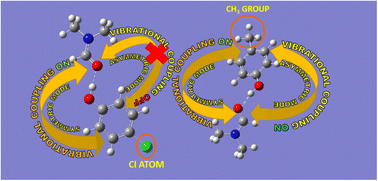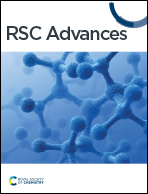Inconsistent hydrogen bond-mediated vibrational coupling of amide I†
Abstract
Using infrared spectroscopy and density functional theory (DFT) calculations, we scrutinized an amide (dimethylformamide) as a “model” compound to interpret the interactions of amide 1 with different phenol derivatives (para-chlorophenol (PCP) and para-cresol (CP)) as “model guest molecules”. We established the involvement of amide I in vibrational coupling with symmetric and asymmetric C![[double bond, length as m-dash]](https://www.rsc.org/images/entities/char_e001.gif) C modes of different phenolic derivatives and how their coupling was dependent upon different guest aromatic phenolic compounds. Interestingly, substitution of phenol perturbed the pattern of vibrational coupling with amide I. The symmetric and asymmetric C
C modes of different phenolic derivatives and how their coupling was dependent upon different guest aromatic phenolic compounds. Interestingly, substitution of phenol perturbed the pattern of vibrational coupling with amide I. The symmetric and asymmetric C![[double bond, length as m-dash]](https://www.rsc.org/images/entities/char_e001.gif) C modes of PC were coupled significantly with amide 1. For PCP, the symmetric C
C modes of PC were coupled significantly with amide 1. For PCP, the symmetric C![[double bond, length as m-dash]](https://www.rsc.org/images/entities/char_e001.gif) C mode coupled significantly, but the asymmetric mode coupled negligibly, with amide I. Here, we reveal the nature of vibrational coupling based on the structure of a guest molecule hydrogen-bonded with amide I. Our conclusions could be valuable for depiction of the unusual dynamics of coupled amide-I modes as well as the dependency of vibrational coupling on altered factors.
C mode coupled significantly, but the asymmetric mode coupled negligibly, with amide I. Here, we reveal the nature of vibrational coupling based on the structure of a guest molecule hydrogen-bonded with amide I. Our conclusions could be valuable for depiction of the unusual dynamics of coupled amide-I modes as well as the dependency of vibrational coupling on altered factors.



 Please wait while we load your content...
Please wait while we load your content...